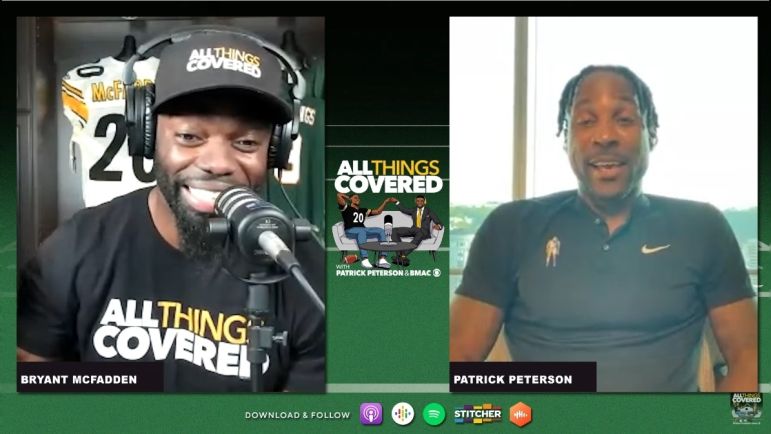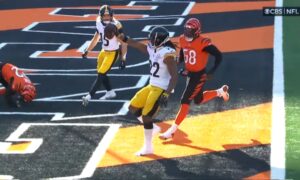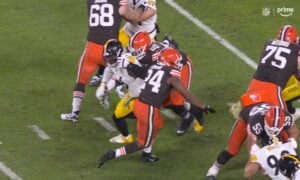The Pittsburgh Steelers’ 2005 playoff run was a historic one, the first-ever sixth seed to win a Super Bowl. To do that meant winning three AFC playoff games on the road. After beating the Cincinnati Bengals in the Wild Card Round, they entered Divisional Weekend as extreme underdogs to the #1 seed Indianapolis Colts.
But the Steelers upset them in nail-biting fashion, Colts’ kicker Mike Vanderjagt missing wide right on a game-tying field goal following Jerome Bettis’ famous fumble (and Ben Roethlisberger’s equally famous tackle). While how the game ended is the story that’s remembered today, what shouldn’t be forgotten is how the Steelers’ defense made life miserable for QB Peyton Manning.
Following a 2004 MVP season, Manning remained a top quarterback in 2005. But Pittsburgh made him look mortal that day, going just 22 of 38 with only one touchdown and five sacks, a stark contrast from the Steelers/Colts previous meeting which Indianapolis won handily. And Manning should’ve had an interception too if the refs didn’t botch things with Troy Polamalu.
It was a masterful playoff performance by a swarming Steelers defense. On the latest episode of the All Things Covered podcast with Bryant McFadden and Patrick Peterson, McFadden – a rookie that year – discussed how DC Dick LeBeau came up with the perfect gameplan.
“The first time, they kicked us in the mouth,” McFadden told Peterson. “Monday Night Football. So Dick LeBeau came up with a gameplan. At that time, the Colts ran a no huddle. It was a tempo. But he told us, ‘It’s a fake tempo. It’s not a real tempo, guys.’ And we were like, what do you mean, Coach?…He said they’re not running tempo. What they’re doing is they’re trying to get you to show your hand. When you show your hand, all Peyton does is look at your defense. He calls a counter to what you are showing him and he’s going to execute it because he knows what you’re in.”
Manning was and remains one of the smartest quarterbacks to ever play the game. With his film study and incredible recall ability, he was able to understand the coverage he was getting pre-snap and knew exactly where to go with the football with some pretty good weapons to hit too in WRs Marvin Harrison and Reggie Wayne along with TE Dallas Clark. To Manning’s Colts, most defenses were sitting ducks. But LeBeau stayed one step ahead.
“Dick LeBeau said, ‘What we’re gonna do guys, is we’re gonna watch the play clock. When the Colts come to the line of scrimmage, don’t even look at the formation. I already gave you the call, but I want you guys in the second and third level to show the same shell every time. And when the play clock hits eight, roll into whatever it is I call. He won’t have enough time to counter.’ So in the week of prep, getting ready for that game playoff game, it was so unfamiliar.”
What LeBeau instructed Pittsburgh to do is not give Manning the answers to the test. By holding their coverage and showing the same “shell” – the secondary/coverage structure – there was no way for Manning to know what he was getting on a certain play. And by the time Pittsburgh rolled into their look, with the play clock winding down, there was no time for Manning to call an audible or adjustment to put the Colts in the best concept to counter.
Manning thrived off information. And Pittsburgh provided none of it. That was the way to beat him.
Here’s a couple examples from early in the game, which Manning started an ugly 0 of 4 and allowed Pittsburgh to build a 14-0 lead. While we don’t have the All-22 that would show the safety rotation more, you can see the secondary shift late in the play clock and on the snap of the football. Watch LCB Ike Taylor at the top, playing off before coming down and jam the receiver in a Cover 2 look you don’t sense pre-snap.
Not only did that force Manning and the receivers to react on the fly, it slowed down their tempo. That made Manning hold onto the ball longer and process what he was seeing, allowing the Steelers’ fierce pass rush to get home. In 16 regular-season games in 2005, Manning was sacked just 17 times. In the playoff loss, Pittsburgh dropped him five times.
The only issue Pittsburgh had was getting away from that gameplan late in the game, allowing the Colts to claw their way back into the game. Instead of the same static shell, the Steelers began to tip their hand.
“Instead of us keeping the shell, we’re lining up in what we in,” McFadden said. “So I’m the only rookie on the field. I said, ‘Hey, what happened to the freaking shell?'”
But it was enough to win and that’s all that matters.
A brilliant gameplan from LeBeau that propelled Pittsburgh to the Super Bowl. Of course, LeBeau wasn’t the only factor for upsetting the Colts. McFadden himself had a key end zone breakup on Indy’s final drive to force them to attempt Vanderjagt’s failed field goal.
Still, it’s moments like these that made LeBeau the Hall of Famer he is. And it was a great story McFadden shared. Check out the full episode below.








